Haijiang Zhu
Cross-Modal Geometric Hierarchy Fusion: An Implicit-Submap Driven Framework for Resilient 3D Place Recognition
Jun 17, 2025Abstract:LiDAR-based place recognition serves as a crucial enabler for long-term autonomy in robotics and autonomous driving systems. Yet, prevailing methodologies relying on handcrafted feature extraction face dual challenges: (1) Inconsistent point cloud density, induced by ego-motion dynamics and environmental disturbances during repeated traversals, leads to descriptor instability, and (2) Representation fragility stems from reliance on single-level geometric abstractions that lack discriminative power in structurally complex scenarios. To address these limitations, we propose a novel framework that redefines 3D place recognition through density-agnostic geometric reasoning. Specifically, we introduce an implicit 3D representation based on elastic points, which is immune to the interference of original scene point cloud density and achieves the characteristic of uniform distribution. Subsequently, we derive the occupancy grid and normal vector information of the scene from this implicit representation. Finally, with the aid of these two types of information, we obtain descriptors that fuse geometric information from both bird's-eye view (capturing macro-level spatial layouts) and 3D segment (encoding micro-scale surface geometries) perspectives. We conducted extensive experiments on numerous datasets (KITTI, KITTI-360, MulRan, NCLT) across diverse environments. The experimental results demonstrate that our method achieves state-of-the-art performance. Moreover, our approach strikes an optimal balance between accuracy, runtime, and memory optimization for historical maps, showcasing excellent Resilient and scalability. Our code will be open-sourced in the future.
Diabetic retinopathy image classification method based on GreenBen data augmentation
Oct 12, 2024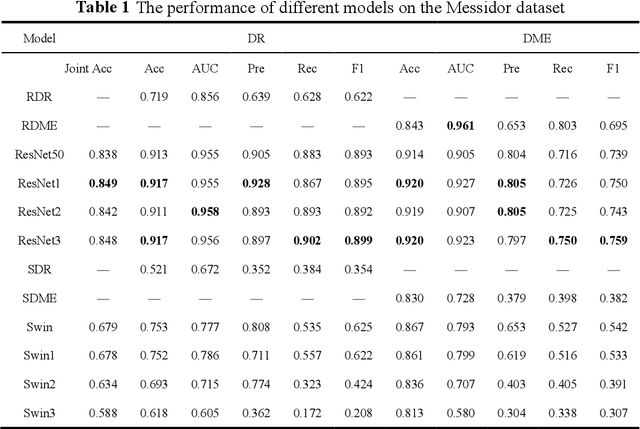

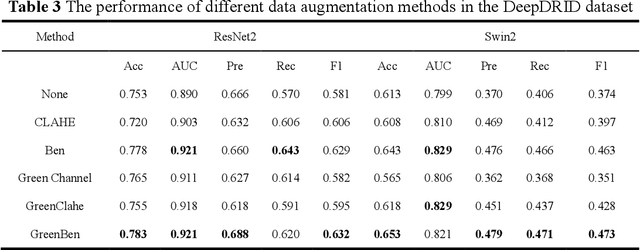
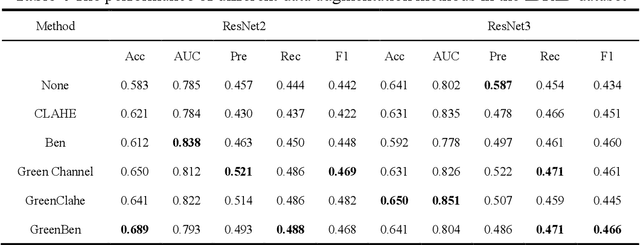
Abstract:For the diagnosis of diabetes retinopathy (DR) images, this paper proposes a classification method based on artificial intelligence. The core lies in a new data augmentation method, GreenBen, which first extracts the green channel grayscale image from the retinal image and then performs Ben enhancement. Considering that diabetes macular edema (DME) is a complication closely related to DR, this paper constructs a joint classification framework of DR and DME based on multi task learning and attention module, and uses GreenBen to enhance its data to reduce the difference of DR images and improve the accuracy of model classification. We conducted extensive experiments on three publicly available datasets, and our method achieved the best results. For GreenBen, whether based on the ResNet50 network or the Swin Transformer network, whether for individual classification or joint DME classification, compared with other data augmentation methods, GreenBen achieved stable and significant improvements in DR classification results, with an accuracy increase of 10%.
ODC-SA Net: Orthogonal Direction Enhancement and Scale Aware Network for Polyp Segmentation
May 10, 2024Abstract:Accurate polyp segmentation is crucial for the early detection and prevention of colorectal cancer. However, the existing polyp detection methods sometimes ignore multi-directional features and drastic changes in scale. To address these challenges, we design an Orthogonal Direction Enhancement and Scale Aware Network (ODC-SA Net) for polyp segmentation. The Orthogonal Direction Convolutional (ODC) block can extract multi-directional features using transposed rectangular convolution kernels through forming an orthogonal feature vector basis, which solves the issue of random feature direction changes and reduces computational load. Additionally, the Multi-scale Fusion Attention (MSFA) mechanism is proposed to emphasize scale changes in both spatial and channel dimensions, enhancing the segmentation accuracy for polyps of varying sizes. Extraction with Re-attention Module (ERA) is used to re-combinane effective features, and Structures of Shallow Reverse Attention Mechanism (SRA) is used to enhance polyp edge with low level information. A large number of experiments conducted on public datasets have demonstrated that the performance of this model is superior to state-of-the-art methods.
Mask-TS Net: Mask Temperature Scaling Uncertainty Calibration for Polyp Segmentation
May 09, 2024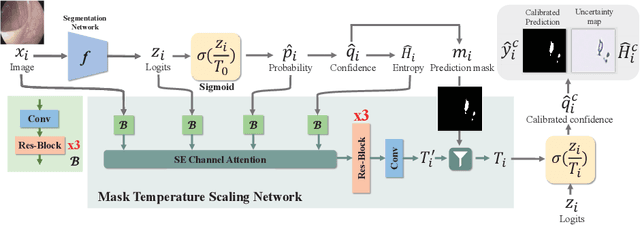

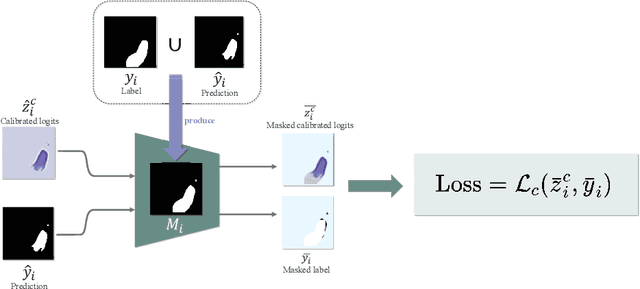

Abstract:Lots of popular calibration methods in medical images focus on classification, but there are few comparable studies on semantic segmentation. In polyp segmentation of medical images, we find most diseased area occupies only a small portion of the entire image, resulting in previous models being not well-calibrated for lesion regions but well-calibrated for background, despite their seemingly better Expected Calibration Error (ECE) scores overall. Therefore, we proposed four-branches calibration network with Mask-Loss and Mask-TS strategies to more focus on the scaling of logits within potential lesion regions, which serves to mitigate the influence of background interference. In the experiments, we compare the existing calibration methods with the proposed Mask Temperature Scaling (Mask-TS). The results indicate that the proposed calibration network outperforms other methods both qualitatively and quantitatively.
 Add to Chrome
Add to Chrome Add to Firefox
Add to Firefox Add to Edge
Add to Edge